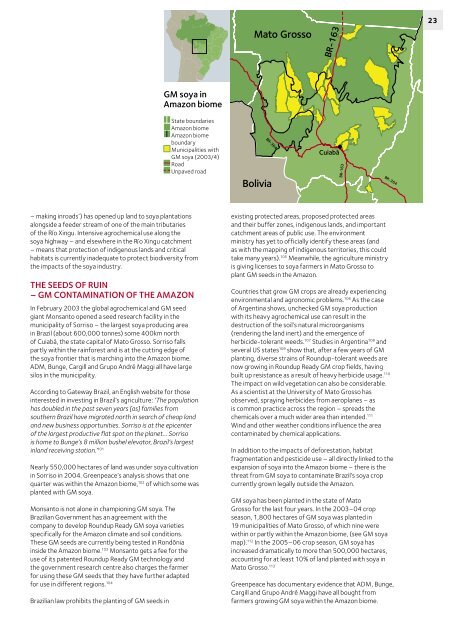EATING UP THE AMAZON 1
EATING UP THE AMAZON 1
EATING UP THE AMAZON 1
Create successful ePaper yourself
Turn your PDF publications into a flip-book with our unique Google optimized e-Paper software.
Mato Grosso<br />
BR-163<br />
<strong>EATING</strong> <strong>UP</strong><br />
<strong>THE</strong> <strong>AMAZON</strong><br />
23<br />
GM soya in<br />
Amazon biome<br />
State boundaries<br />
Amazon biome<br />
Amazon biome<br />
boundary<br />
Municipalities with<br />
GM soya (2003/4)<br />
Road<br />
Unpaved road<br />
BR-364<br />
Bolivia<br />
Cuiabá<br />
BR-163<br />
BR-364<br />
– making inroads’) has opened up land to soya plantations<br />
alongside a feeder stream of one of the main tributaries<br />
of the Río Xingu. Intensive agrochemical use along the<br />
soya highway – and elsewhere in the Río Xingu catchment<br />
– means that protection of indigenous lands and critical<br />
habitats is currently inadequate to protect biodiversity from<br />
the impacts of the soya industry.<br />
<strong>THE</strong> SEEDS OF RUIN<br />
– GM CONTAMINATION OF <strong>THE</strong> <strong>AMAZON</strong><br />
In February 2003 the global agrochemical and GM seed<br />
giant Monsanto opened a seed research facility in the<br />
municipality of Sorriso – the largest soya producing area<br />
in Brazil (about 600,000 tonnes) some 400km north<br />
of Cuiabá, the state capital of Mato Grosso. Sorriso falls<br />
partly within the rainforest and is at the cutting edge of<br />
the soya frontier that is marching into the Amazon biome.<br />
ADM, Bunge, Cargill and Grupo André Maggi all have large<br />
silos in the municipality.<br />
According to Gateway Brazil, an English website for those<br />
interested in investing in Brazil’s agriculture: ‘The population<br />
has doubled in the past seven years [as] families from<br />
southern Brazil have migrated north in search of cheap land<br />
and new business opportunities. Sorriso is at the epicenter<br />
of the largest productive flat spot on the planet… Sorriso<br />
is home to Bunge’s 8 million bushel elevator, Brazil’s largest<br />
inland receiving station.’ 101<br />
Nearly 550,000 hectares of land was under soya cultivation<br />
in Sorriso in 2004. Greenpeace‘s analysis shows that one<br />
quarter was within the Amazon biome, 102 of which some was<br />
planted with GM soya.<br />
Monsanto is not alone in championing GM soya. The<br />
Brazilian Government has an agreement with the<br />
company to develop Roundup Ready GM soya varieties<br />
specifically for the Amazon climate and soil conditions.<br />
These GM seeds are currently being tested in Rondônia<br />
inside the Amazon biome. 103 Monsanto gets a fee for the<br />
use of its patented Roundup Ready GM technology and<br />
the government research centre also charges the farmer<br />
for using these GM seeds that they have further adapted<br />
for use in different regions. 104<br />
Brazilian law prohibits the planting of GM seeds in<br />
existing protected areas, proposed protected areas<br />
and their buffer zones, indigenous lands, and important<br />
catchment areas of public use. The environment<br />
ministry has yet to officially identify these areas (and<br />
as with the mapping of indigenous territories, this could<br />
take many years). 105 Meanwhile, the agriculture ministry<br />
is giving licenses to soya farmers in Mato Grosso to<br />
plant GM seeds in the Amazon.<br />
Countries that grow GM crops are already experiencing<br />
environmental and agronomic problems. 106 As the case<br />
of Argentina shows, unchecked GM soya production<br />
with its heavy agrochemical use can result in the<br />
destruction of the soil’s natural microorganisms<br />
(rendering the land inert) and the emergence of<br />
herbicide-tolerant weeds. 107 Studies in Argentina 108 and<br />
several US states 109 show that, after a few years of GM<br />
planting, diverse strains of Roundup-tolerant weeds are<br />
now growing in Roundup Ready GM crop fields, having<br />
built up resistance as a result of heavy herbicide usage. 110<br />
The impact on wild vegetation can also be considerable.<br />
As a scientist at the University of Mato Grosso has<br />
observed, spraying herbicides from aeroplanes – as<br />
is common practice across the region – spreads the<br />
chemicals over a much wider area than intended. 111<br />
Wind and other weather conditions influence the area<br />
contaminated by chemical applications.<br />
In addition to the impacts of deforestation, habitat<br />
fragmentation and pesticide use – all directly linked to the<br />
expansion of soya into the Amazon biome – there is the<br />
threat from GM soya to contaminate Brazil’s soya crop<br />
currently grown legally outside the Amazon.<br />
GM soya has been planted in the state of Mato<br />
Grosso for the last four years. In the 2003–04 crop<br />
season, 1,800 hectares of GM soya was planted in<br />
19 municipalities of Mato Grosso, of which nine were<br />
within or partly within the Amazon biome, (see GM soya<br />
map). 112 In the 2005–06 crop season, GM soya has<br />
increased dramatically to more than 500,000 hectares,<br />
accounting for at least 10% of land planted with soya in<br />
Mato Grosso. 113<br />
Greenpeace has documentary evidence that ADM, Bunge,<br />
Cargill and Grupo André Maggi have all bought from<br />
farmers growing GM soya within the Amazon biome.




![[2007] EWHC 311 - Greenpeace UK](https://img.yumpu.com/22079793/1/184x260/2007-ewhc-311-greenpeace-uk.jpg?quality=85)











